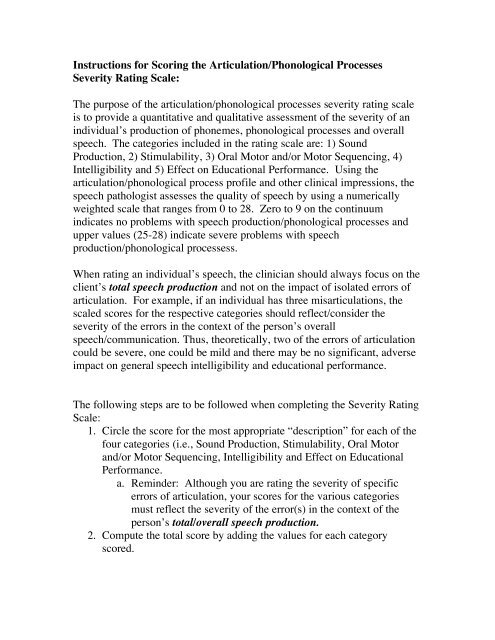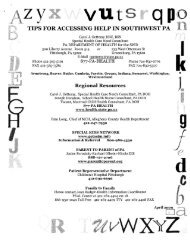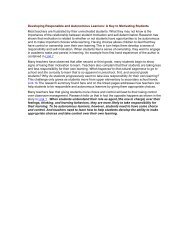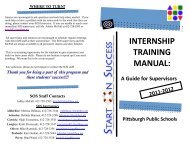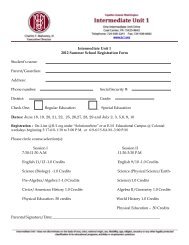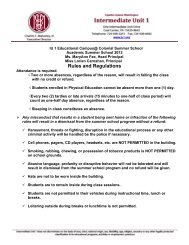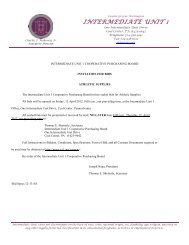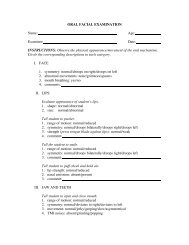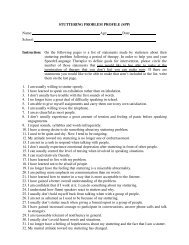Articulation/Phonological Processes Severity Rating Scale
Articulation/Phonological Processes Severity Rating Scale
Articulation/Phonological Processes Severity Rating Scale
Create successful ePaper yourself
Turn your PDF publications into a flip-book with our unique Google optimized e-Paper software.
Instructions for Scoring the <strong>Articulation</strong>/<strong>Phonological</strong> <strong>Processes</strong><br />
<strong>Severity</strong> <strong>Rating</strong> <strong>Scale</strong>:<br />
The purpose of the articulation/phonological processes severity rating scale<br />
is to provide a quantitative and qualitative assessment of the severity of an<br />
individual’s production of phonemes, phonological processes and overall<br />
speech. The categories included in the rating scale are: 1) Sound<br />
Production, 2) Stimulability, 3) Oral Motor and/or Motor Sequencing, 4)<br />
Intelligibility and 5) Effect on Educational Performance. Using the<br />
articulation/phonological process profile and other clinical impressions, the<br />
speech pathologist assesses the quality of speech by using a numerically<br />
weighted scale that ranges from 0 to 28. Zero to 9 on the continuum<br />
indicates no problems with speech production/phonological processes and<br />
upper values (25-28) indicate severe problems with speech<br />
production/phonological processess.<br />
When rating an individual’s speech, the clinician should always focus on the<br />
client’s total speech production and not on the impact of isolated errors of<br />
articulation. For example, if an individual has three misarticulations, the<br />
scaled scores for the respective categories should reflect/consider the<br />
severity of the errors in the context of the person’s overall<br />
speech/communication. Thus, theoretically, two of the errors of articulation<br />
could be severe, one could be mild and there may be no significant, adverse<br />
impact on general speech intelligibility and educational performance.<br />
The following steps are to be followed when completing the <strong>Severity</strong> <strong>Rating</strong><br />
<strong>Scale</strong>:<br />
1. Circle the score for the most appropriate “description” for each of the<br />
four categories (i.e., Sound Production, Stimulability, Oral Motor<br />
and/or Motor Sequencing, Intelligibility and Effect on Educational<br />
Performance.<br />
a. Reminder: Although you are rating the severity of specific<br />
errors of articulation, your scores for the various categories<br />
must reflect the severity of the error(s) in the context of the<br />
person’s total/overall speech production.<br />
2. Compute the total score by adding the values for each category<br />
scored.
3. Circle total score on the bar/scale at the bottom of the table. The<br />
severity of the individual’s errors of articulation is classified on the<br />
bar/scale as normal/adequate, mild, moderate or severe.<br />
4.Answer yes or no to the final statements at the bottom of the form.
Student: Date:<br />
School:<br />
SLP:<br />
ARTICULATION/PHONOLOGICAL PROCESSES SEVERITY RATING SCALE<br />
Sound Production 0<br />
Student’s speech is<br />
characterized by no<br />
sound errors or errors<br />
consistent with normal<br />
development.<br />
Stimulability 0<br />
Most error sounds are<br />
stimulable for correct<br />
production in several<br />
contexts.<br />
Oral Motor<br />
and/or<br />
Motor Sequencing<br />
0<br />
Oral motor and/or<br />
sequencing adequate for<br />
speech production.<br />
Intelligibility 0<br />
Connected speech is<br />
intelligible.<br />
Effect on Educational<br />
Performance<br />
Social<br />
Emotional<br />
Academic<br />
Vocational<br />
0<br />
No interference with the<br />
child’s participation in<br />
educational setting.<br />
Acquisition of basic<br />
cognitive and/or affective<br />
performance skills is not<br />
affected.<br />
2<br />
Student’s speech is<br />
characterized by sound<br />
errors 6 mos. to one year<br />
below develop-mental<br />
age/chronological age.<br />
2<br />
Most error sounds are<br />
stimulable in at least<br />
one context.<br />
2<br />
Oral motor and/or<br />
sequencing difficulties<br />
are minimal and do not<br />
contribute to speech<br />
production problems.<br />
4<br />
Connected speech is<br />
intelligible some errors<br />
noticeable; more than<br />
80% intelligible.<br />
4<br />
Minimal impact on the<br />
child’s participation in<br />
the educational setting.<br />
Acquisition of basic<br />
cognitive and/or affective<br />
performance skills may<br />
be affected.<br />
3<br />
Student’s speech is<br />
characterized by sound<br />
errors from one to two<br />
years below developmental<br />
age/chronological age.<br />
3<br />
Although not correct, most<br />
error sounds approximate<br />
correct production.<br />
3<br />
Oral motor and/or<br />
sequencing difficulties<br />
interfere with speech<br />
production.<br />
6<br />
Connected speech<br />
sometimes unintelligible<br />
when context is unknown;<br />
50-80% intelligible.<br />
6<br />
Does interfere with child’s<br />
participation in the<br />
educational setting.<br />
Acquisition of basic<br />
cognitive and/or affective<br />
performance skills is usually<br />
affected.<br />
4<br />
Student’s speech is<br />
characterized by sound<br />
errors more than two<br />
years below<br />
developmental/<br />
chronological age.<br />
4<br />
No error sounds are<br />
stimulable for correct<br />
production.<br />
4<br />
Oral motor and/or<br />
sequencing greatly<br />
interfere with speech<br />
production, use of cues,<br />
gestures or AD needed.<br />
8<br />
Connected speech<br />
mostly unintelligible;<br />
gestures/cues usually<br />
needed; less than 50%<br />
intelligible.<br />
8<br />
Seriously limits child’s<br />
participation in the<br />
educational setting.<br />
Acquisition of basic<br />
cognitive and/or<br />
affective<br />
performance skills is<br />
impaired.<br />
Total Score 0 2 3 4 5 6 7 8 9 10 11 12 13 14 15 16 17 18 19 20 21 22 23 24 25 26 27 28<br />
<strong>Rating</strong> Score Normal/Adequate Mild Moderate Severe
Based on compilation of the assessment data, this student scores in the Mild, Moderate or Severe range or the <strong>Articulation</strong> <strong>Severity</strong> <strong>Rating</strong> <strong>Scale</strong>. Yes No<br />
This assessment provides documentation/supporting evidence of adverse effects of the Speech Sound production on educational performance. Yes No<br />
(BOTH STATEMENTS ABOVE MUST BE CHECKED YES)


